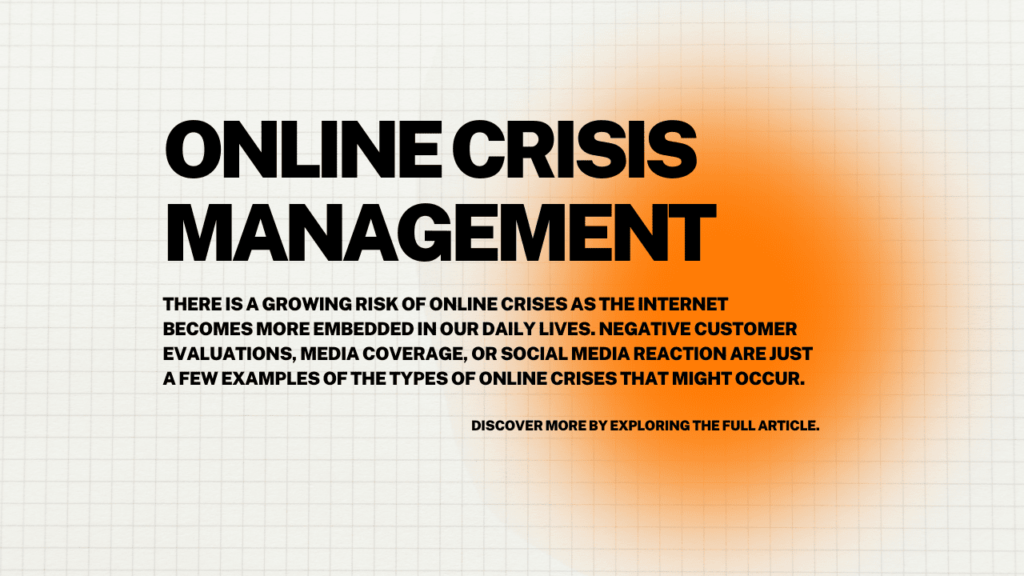İnternet günlük hayatımıza daha fazla yerleştikçe çevrimiçi kriz riski de artıyor. Olumsuz müşteri değerlendirmeleri, medya kapsamı veya sosyal medya tepkisi, ortaya çıkabilecek çevrimiçi kriz türlerine sadece birkaç örnektir. Dijital alanda kriz yönetimi, bu tür durumları önlemeyi, çözmeyi ve bunlardan kurtulmayı içerir. Dijital alanda bir krizle başa çıkmanın tüm ayrıntıları burada ele alınacaktır.
🚨Krizi Tanımlayın
Sorunun ne olduğunu bulmak, dijital alanda bir krizle başa çıkmanın ilk adımıdır. Olumsuz geri bildirimleri yakalamak için sosyal medya, inceleme siteleri ve haberler dahil olmak üzere çeşitli web kaynaklarını takip etmek çok önemlidir. Bunu inceleme sitelerini izleyerek, markanız çevrimiçi olarak her anıldığında Google Uyarıları ayarlayarak ve sosyal medyayı sık sık kontrol ederek başarabilirsiniz. Bir krizin farkına varıldıktan sonra derinliğini ve genişliğini değerlendirmek çok önemlidir.
🚨Bir Plan Geliştirin
Kriz fark edildikten sonra bir krizle başa çıkmak için bir strateji formüle etmek önemlidir. Bir tepki stratejisi ve halkla iletişim kurmanın bir yolu planın bir parçası olmalıdır. Bir krize yanıt verme stratejisi, alınacak eylemleri ayrıntılı olarak belirtmelidir. Yasal işlem yapmak, müşteri şikayetlerini ele almak veya zararlı içerikleri ortadan kaldırmak seçenekler arasındadır. Tüketiciler, çalışanlar ve hissedarlar dahil olmak üzere paydaşların tümü kriz iletişim planında dikkate alınmalıdır.
Kriz Yönetimi
🚨Hızlı Tepki Verin
İnternet krizinin yönetimi acil eylem gerektirir. Hızlı bir şekilde eylem yapılırsa sorun yatıştırılabilir. Bir kriz tanımlandıktan sonraki 24 saat içinde bir tepki verilmelidir. Samimiyet, sempati ve açıklık, bir yanıtta gerekli niteliklerdir. Sorunu tanımalı ve onu düzeltmenin bir yolunu önermeli veya en azından bir çözüm üzerinde çalışmaya başlamalıdır.
🚨Etkili İletişim Kurun
Çevrimiçi bir krizin yönetimi büyük ölçüde etkili iletişime dayanır. Durumun durumu ve düzeltmek için alınan önlemler konusunda herkesi bilgilendirmek önemlidir. Bu, çevrimiçi gönderiler, e-posta bültenleri veya gazete veya dergi gibi geleneksel medya aracılığıyla gerçekleştirilebilir. Konuşmada sürekli açıklık ve dürüstlük oldukça değerlidir. Sonuç olarak, markanın itibarı kurtarılabilir ve paydaşlarıyla güven güçlendirilebilir.
🚨İzleme ve Değerlendirme
Krizin sonrasını izlemek ve değerlendirmek çok önemlidir. Bu amaçla, inceleme ve sosyal medya platformlarını kontrol ederek ek kötü geri bildirimlere dikkat etmek mümkündür. Tepkinin etkinliği ve iletişim stratejileri de değerlendirilmelidir. Bu, gelecekteki krizlerle daha iyi nasıl başa çıkılacağını planlamak için yararlı olabilir.
Sonuç olarak, dijital çağda kriz yönetimi, her şirket için temel bir işlevdir. Sorunun doğasını anlamak, bir yanıt formüle etmek, hızlı hareket etmek, açık iletişim hatlarını sürdürmek ve sonrasını takip etmek hayati önem taşır. Şirketler bu önlemleri alarak çevrimiçi krizin etkisini azaltabilir ve imajlarını koruyabilirler.




